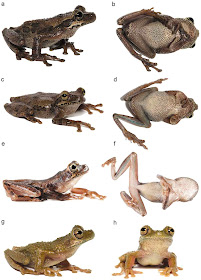 |
| Osteocephalus sangay
Chasiluisa, Caminer, Varela-Jaramillo & Ron, 2020
|
The Osteocephalus buckleyi species group is widely distributed in primary and secondary forests of the Amazon Basin and Guiana Region. Based on integrative analysis, including morphological and genetic data, we estimate the phylogenetic relationships and species boundaries among populations of the Osteocephalus buckleyi group from the Ecuadorian Amazon, focusing on the O. verruciger-O. cannatellai species complex. Our results uncovered the existence of one confirmed candidate species from Sangay National Park and one unconfirmed candidate species. Here, we describe the new species which is morphologically and ecologically distinct from other Osteocephalus species. The new species is unusual because it shows quite distinct morphology, but low genetic distances compared to its closest relatives.
KEYWORDS: Biodiversity, Ecuador, molecular tools, new species, Osteocephalus
Osteocephalus sangay sp. n.
Proposed standard English name: Sangay casqued Treefrog.
Proposed standard Spanish name: Rana de casco del Sangay.
Diagnosis: The diagnosis and comparisons are based on six adult females and two adult males. Coloration corresponds to live individuals. Osteocephalus sangay sp. n. can be diagnosed by the following characters: (1) mean SVL 40.82 mm in males (range 40.32–41.31; n = 2), 49.65 mm in females (range 46.68–52.82; n = 6) (Table 1); (2) skin on dorsum bearing keratinized tubercles in males and scattered tubercles in females; (3) skin on flanks areolate; (4) hand webbing formula varying from I basal II12/3–3+III22/3–21/3IV to I basal II2–31/3III22/3–21/2IV; foot webbing formula varying from I12/3–2−II1+–2III1−–2−IV2−–1−V to I11/2–2+ II1+–21/3III11/3–2+ IV2-–1-V; (5) dorsum light to medium brown with irregular dark brown marks; (6) venter varying from cream to tan with dark brown dots; (7) cream suborbital mark present; irregular black labial stripe; (8) flanks cream with darker reticulations and brown blotches dorsally; (9) dermal roofing bones of the skull weakly exostosed; (10) bones green in life; (11) iris bronze with irregular black reticulations and olive green ring around the pupil; (12) paired lateral vocal sacs, behind jaw articulation; (13) larvae unknown.
Distribution and ecology: Osteocephalus sangay is known from eastern Ecuador, Morona Santiago province, Sangay National Park, at four nearby localities (maximum distance between localities: 3.7 km), and elevations between 1551 and 1795 m above sea level. Osteocephalus sangay occurs sympatrically with O. verruciger at the type locality (Figure 2). This region corresponds to Eastern Montane Forest (based on Ron et al. [2019] classification). Specimens were found at night in primary terra firme forest, perching on vegetation up to 2 m above the ground.
Etymology: The specific epithet sangay refers to the area where the species was discovered: Sangay National Park, in Morona Santiago province. The park has more than 3220 lakes and three volcanoes: Sangay, Tungurahua and Altar. The word sangay originates from the native-American Shuar word “Samkay” that means to scare, in reference to violent explosions of this volcano. Sangay National Park is one of the most amphibian species-rich national parks in the world with a total of 100 species [Ron et al., 2019].
Valeria D. Chasiluisa, Marcel A. Caminer, Andrea Varela-Jaramillo and Santiago R. Ron. 2020. Description and Phylogenetic Relationships of A New Species of Treefrog of the Osteocephalus buckleyi Species Group (Anura: Hylidae). Neotropical Biodiversity. 6(1); 21-36. DOI: 10.1080/23766808.2020.1729306




